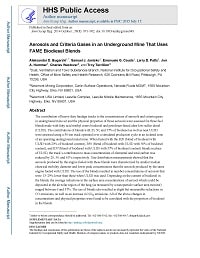Mining Publication: Aerosols and Criteria Gases in an Underground Mine That Uses FAME Biodiesel Blends
Original creation date: October 2014
Authors: AD Bugarski, SJ Janisko, E Cauda, LD Patts, JA Hummer, C Westover, T Terrillion
The contribution of heavy-duty haulage trucks to the concentrations of aerosols and criteria gases in underground mine air and the physical properties of those aerosols were assessed for three fuel blends made with fatty acid methyl esters biodiesel and petroleum-based ultra-low-sulfur diesel (ULSD). The contributions of blends with 20, 50, and 57% of biodiesel as well as neat ULSD were assessed using a 30-ton truck operated over a simulated production cycle in an isolated zone of an operating underground metal mine. When fueled with the B20 (blend of biodiesel with ULSD with 20% of biodiesel content), B50 (blend of biodiesel with ULSD with 50% of biodiesel content), and B57 (blend of biodiesel with ULSD with 57% of biodiesel content) blends in place of ULSD, the truck’s contribution to mass concentrations of elemental and total carbon was reduced by 20, 50, and 61%, respectively. Size distribution measurements showed that the aerosols produced by the engine fueled with these blends were characterized by smaller median electrical mobility diameter and lower peak concentrations than the aerosols produced by the same engine fueled with ULSD. The use of the blends resulted in number concentrations of aerosols that were 13–29% lower than those when ULSD was used. Depending on the content of biodiesel in the blends, the average reductions in the surface area concentrations of aerosol which could be deposited in the alveolar region of the lung (as measured by a nanoparticle surface area monitor) ranged between 6 and 37%. The use of blends also resulted in slight but measurable reductions in CO emissions, as well as an increase in NOX emissions. All of the above changes in concentrations and physical properties were found to be correlated with the proportion of biodiesel in the blends.

- Aerosols Emitted in Underground Mine Air by Diesel Engine Fueled with Biodiesel
- Characterization of Nanometer and Ultrafine Diesel Aerosols in the Underground Mining Environment
- Comparing Measurements of Carbon in Diesel Exhaust Aerosols Using the Aethalometer, NIOSH Method 5040, and SMPS
- Diesel Aerosols and Gases in Underground Mines: Guide to Exposure Assessment and Control
- Effects of Diesel Exhaust Aftertreatment Devices on Concentrations and Size Distribution of Aerosols in Underground Mine Air
- Effects of FAME Biodiesel and HVORD on Emissions from an Older Technology Diesel Engine
- Effects of Sintered Metal Diesel Particulate Filter System on Diesel Aerosols and Nitric Oxides in Mine Air
- Examination of Diesel Aftertreatment Systems at NIOSH Lake Lynn Laboratory
- Mutagenicity of Biodiesel or Diesel Exhaust Particles and the Effect of Engine Operating Conditions
- Toward developing a new occupational exposure metric approach for characterization of diesel aerosols